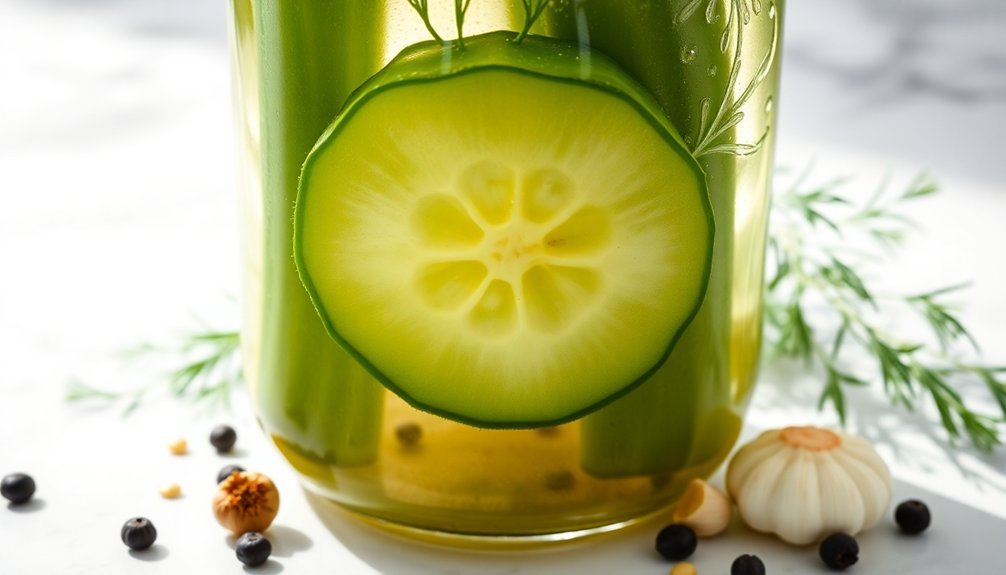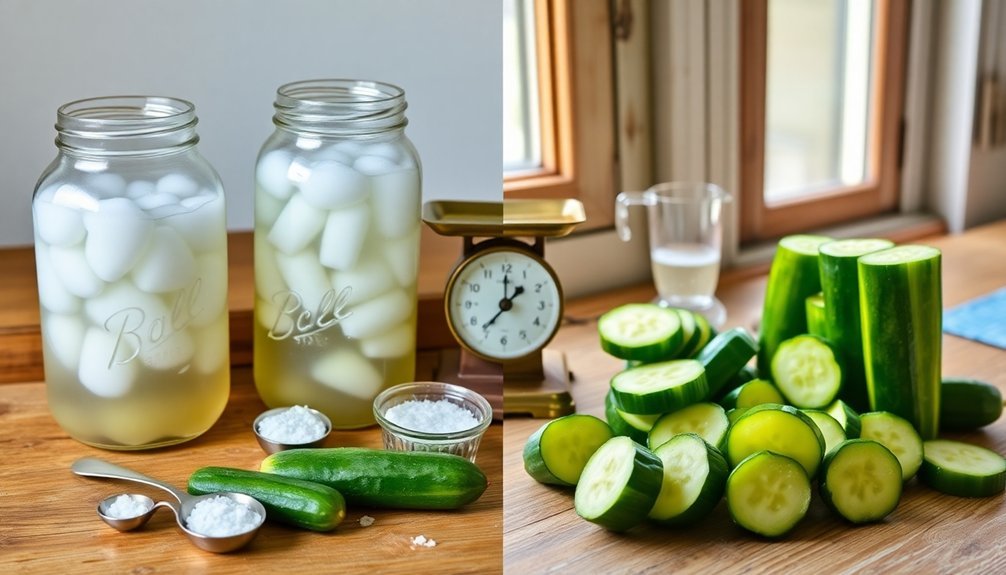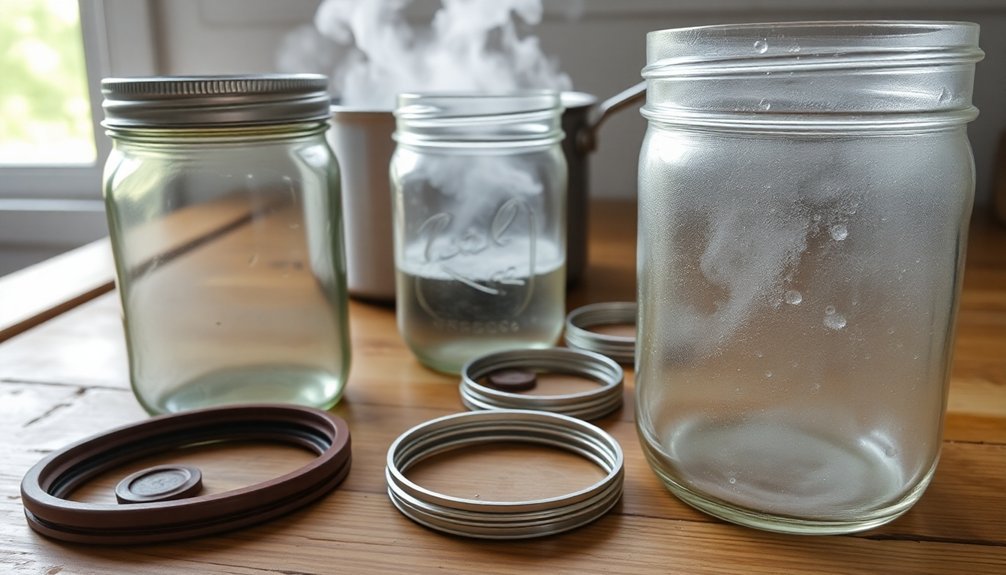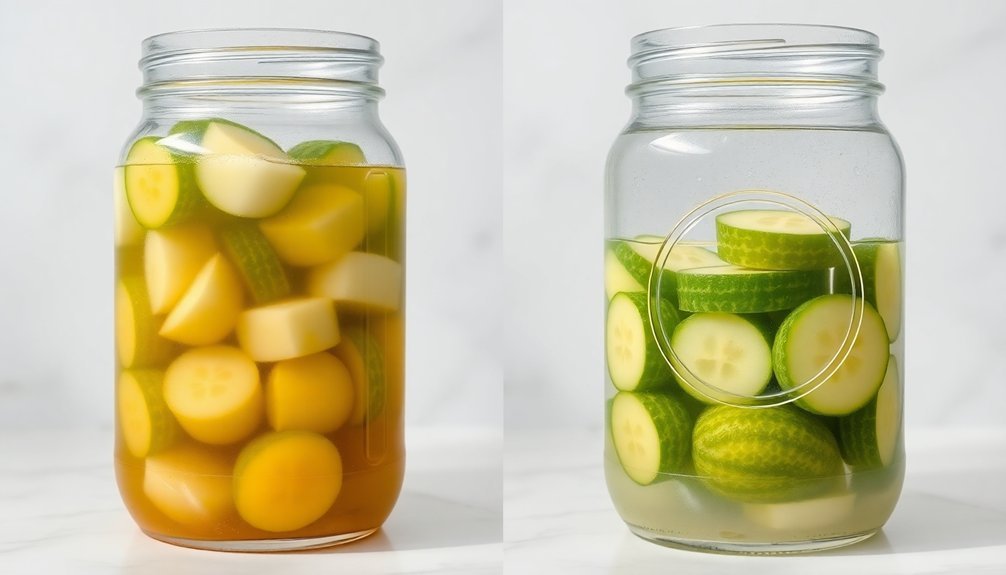If your pickles aren't turning out right, you've got several quick fixes available. For soft pickles, soak them in an ice bath for 4-5 hours to restore crispness. Clear up cloudy brine by straining through cheesecloth or adding natural clarifiers like bay leaves. Adjust too-salty or too-sour brine by creating a new solution with the correct ratios (50:50 vinegar to water). Check jar seals and store in a cool, dark place to prevent spoilage. Monitor brine temperature between 165-180°F for ideal texture. If your pickles are curing unevenly, redistribute them daily in the jar. These solutions just scratch the surface of pickle perfection.
Restoring Crisp Pickle Texture

Many home picklers face the challenge of maintaining perfectly crisp cucumbers during the vinegar pickling process. You'll get the best results by starting with fresh, firm cucumbers and using them within 2-3 days of harvesting. Le Parfait Super Glass Jars are an excellent choice for pickling due to their durability and airtight sealing capabilities.
Select smaller varieties like Kirby or Lebanese cucumbers, and don't forget to trim both ends, especially the blossom end, which contains softening enzymes.
To enhance crispness, soak your cucumbers in ice water for 4-5 hours before pickling. When preparing your brine, you'll need to maintain proper salt concentrations of 2.5-3.5% (about 1.5-2 tablespoons per 1L jar).
Add calcium chloride (pickle crisp) at ¼ to ¾ teaspoon per jar, and include tannin-rich ingredients like grape leaves or black tea.
You'll want to pack your cucumbers tightly in non-reactive jars and guarantee they're completely submerged in the brine. Let your brine cool to room temperature before pouring it over the cucumbers to prevent them from cooking.
Store your pickles in a cool environment, as high temperatures can lead to softening. If your recipe suggests it, use low-temperature pasteurization for peak crispness.
Clearing Cloudy Brine Solutions
Your choice of water can make a significant difference when clearing cloudy pickle brine, as tap water's minerals often contribute to cloudiness while filtered water produces clearer results.
You'll find that natural clarifiers like egg whites or a coffee filter can effectively remove suspended particles without introducing artificial additives to your pickles.
If you're looking for a quicker solution, food-grade chemical clarifiers are available, though they might affect the pickle's flavor profile more than natural methods.
Refrigerated storage of pickles can help minimize cloudiness development, particularly when dealing with large batches of homemade preserves.
Filtered Water Vs Tap
Water choice plays an essential role in successful pickling, especially when dealing with cloudy brine solutions. If you're using tap water, you'll need to address its chlorine content, which can kill beneficial bacteria and interfere with fermentation. You can treat tap water by letting it sit uncovered for several hours or boiling it and allowing it to cool before use.
Filtered water offers distinct advantages for your pickling process. It reduces the risk of cloudy brine in vinegar pickles, where cloudiness might indicate spoilage rather than normal fermentation. When you use filtered water, you're creating an ideal environment for beneficial bacteria while minimizing unwanted particulate matter that could affect clarity. For optimal results, store your pickles at 65° to 75°F to maintain proper fermentation conditions.
While tap water is adequate for cleaning your equipment, you'll want to use filtered water for the brine itself, particularly in canning recipes where long-term quality matters.
If you don't have access to filtered water, you can still achieve good results by properly treating your tap water.
Remember that the water you choose directly impacts your pickles' taste, appearance, and shelf life, so it's worth taking the time to use the right type for your specific pickling method.
Natural Vs Chemical Clarifiers
Clarity in pickling brines comes down to two main approaches: natural and chemical clarifiers.
Natural methods include using fresh herbs like bay leaves and thyme, which enhance both clarity and flavor. You'll want to contain whole spices in cheesecloth to prevent clouding, while ensuring your produce is thoroughly washed and prepped, especially removing cucumber blossom ends.
Chemical clarifiers, like calcium chloride (Pickle Crisp®) and pickling lime, work differently by focusing on the structural integrity of your vegetables. While they're effective, you'll need to follow exact measurements and proper rinsing procedures to maintain safe pH levels.
- Use fresh herbs and spices, contained in cheesecloth, to naturally clarify without compromising flavor
- Remove cucumber blossom ends and wash produce thoroughly to prevent enzyme-related cloudiness
- Cool brine completely before sealing, and store in a dark, cool place
- Maintain proper vinegar-to-water ratios (no more than 50-50 for canning)
- When using chemical clarifiers like pickling lime, measure precisely and rinse thoroughly
Choose natural clarifiers for subtle flavor enhancement and minimal processing, or opt for chemical clarifiers when structural integrity is your primary concern.
Balancing Salt and Vinegar Ratios

Balance lies at the heart of successful pickling, and mastering the relationship between salt and vinegar is essential for creating crisp, flavorful preserves. When your ratios are off, you'll need to adjust carefully. Start with the standard 50:50 vinegar-to-water ratio, ensuring your vinegar has at least 5% acidity. For stronger brines, you can increase the vinegar proportion up to 100%.
| Ingredient Type | Ratio (V:W:S)* | Best Salt Choice |
|---|---|---|
| Root Vegetables | 2:1:1 | Pickling Salt |
| Fruit | 5:3:2:1 | Kosher Salt |
| Cucumbers | 1:1:0.5 | Sea Salt |
| Mixed Veggies | 3:2:1 | Canning Salt |
*V=Vinegar, W=Water, S=Salt
If your pickles taste too acidic, don't dilute the brine directly. Instead, create a new solution with the correct proportions and replace the existing brine. Remember to use only noniodized salt varieties to prevent cloudiness. You can blend different vinegars to create unique flavor profiles, but maintain the total acidity level. For delicate ingredients like pears, opt for milder vinegars like rice or white wine varieties, while hardier vegetables can handle stronger options.
Preventing Spoilage During Storage
To keep your pickled creations safe and delicious for months, proper storage practices are essential. You'll need to store your pickles in a dark, cool, and dry location where temperature remains consistent. Choose glass jars with self-sealing lids, as they won't react with the acidic contents and provide the best protection against spoilage. Always sterilize your containers before use by placing them in boiling water, and guarantee you're using vinegar with at least 5% acidity.
Keep these critical storage guidelines in mind:
- Store jars in a location away from direct sunlight to prevent color changes and maintain quality.
- Check that jar lids are properly sealed and don't flex when pressed.
- Monitor storage area humidity levels to prevent mold development.
- Keep containers undisturbed to maintain seal integrity.
- Maintain consistent temperature throughout storage period.
If you notice any signs of spoilage, such as bubbling, cloudiness, or off-odors, don't take chances – discard the affected jars immediately.
Remember that proper storage begins with correct preparation, so always use fresh produce and follow tested recipes precisely. These preventive measures will help guarantee your pickles remain safe and flavorful throughout their shelf life.
Fixing Broken Jar Seals

Even with careful storage practices, you may sometimes discover a jar that hasn't sealed properly. When this happens, you'll need to identify the cause and take immediate action to save your pickles.
Check the canning environment first. Your water bath must maintain a full, rolling boil throughout the process, with water levels at least 1 inch above jar tops. Without adequate heat, oxygen won't vent properly from the headspace, preventing a vacuum seal.
Examine the jar's physical condition. Wipe rims thoroughly to remove food particles or debris that could block the seal. Don't reuse old lids, and inspect jar rims for chips or cracks. Make sure you've tightened the rings appropriately and maintained proper headspace—typically 1/2 inch for pickles.
If you need to reprocess jars, let them cool completely first. Use new lids and clean the rims again. Start with room temperature jars in cold water, then bring to a boil slowly.
Once boiling, process as usual. Test the seal by lifting the lid's edge; it should stay firmly in place. Remember to adjust headspace after removing air bubbles to prevent seal failures.
Adjusting Brine Temperature Issues
If you're finding your brine's too hot (above 180°F), you'll end up with mushy pickles that lack the satisfying crunch you're after.
When your brine's too cold, you won't get the proper flavor infusion or the right preservation process happening in your jars.
The sweet spot lies between 165-180°F during canning and 70-75°F during fermentation, giving you perfectly crisp, flavorful pickles every time.
Too Hot Kills Crunch
Temperature control is your vinegar pickling's secret weapon for maintaining that sought-after crunch. When you're processing pickles, you'll want to maintain temperatures between 180-185°F – going higher will turn your crisp cucumbers into mushy disappointments.
Low-temperature pasteurization offers superior results compared to traditional boiling water bath methods, but you'll need to monitor it carefully with a candy or jelly thermometer.
Start with warm water (120-140°F) in your canner, then adjust to reach the target range. Remember to keep water at least an inch above your jars during the 30-minute processing time. You'll get the best results by heating your brine to boiling just before filling jars, then moving quickly to processing.
- Keep temperatures below 185°F to preserve crunchiness
- Monitor constantly with a reliable thermometer
- Process for exactly 30 minutes – no more, no less
- Use fresh cucumbers processed within 24 hours of harvest
- Remove blossom ends before processing to maintain firmness
If you've already processed at too high a temperature, there's unfortunately no way to restore crunch – prevention is your only solution.
Cold Brine Weakens Flavor
Properly heated brine is essential for developing robust pickle flavor. When you're using cold brine, you'll notice your pickles often lack that signature tangy taste and might end up with a weaker overall profile. To fix this issue, you'll need to address both temperature and composition of your brine solution.
| Temperature Issue | Quick Solution |
|---|---|
| Cold brine | Heat to 160-180°F |
| Weak vinegar | Use 5% acidity minimum |
| Poor salt ratio | Follow 1:16 salt-to-water |
| Improper mixing | Dissolve all ingredients hot |
| Uneven distribution | Pour brine while hot |
Your brine's effectiveness depends heavily on proper temperature control. Heat your vinegar solution to the correct temperature before adding it to your cucumbers. This helps the vegetables absorb the flavoring compounds more effectively. Don't forget to check your vinegar's acidity level – it must be at least 5% for proper pickling. If you're using pickling cucumbers, remove their blossom ends and verify they're free from any wax coating. Keep your pickles fully submerged in the brine throughout the process, and store them at appropriate temperatures to maintain ideal flavor development.
Perfect Temperature Sweet Spot
Building on the basics of brine heating, achieving the perfect temperature sweet spot requires precise control throughout the pickling process. You'll need to maintain temperatures between 180°F and 185°F during processing to guarantee both safety and ideal texture.
Start by placing your filled jars in warm water (120°F to 140°F), then add hot water until it's one inch above the jars.
Keep a reliable thermometer handy that can measure within the 120°F to 185°F range. If you let temperatures rise above 185°F, you'll end up with unnecessarily soft pickles. Conversely, dropping below 180°F during the 30-minute processing time can compromise food safety.
- Use an instant-read or candy thermometer to monitor temperature consistently
- Process jars at 180°F-185°F for the recommended time based on jar size and altitude
- Keep water level one inch above jars throughout processing
- Start timing only after water reaches the correct temperature
- Check temperature frequently to maintain the sweet spot
Don't skip temperature monitoring – it's essential for preventing common issues like soft or hollow pickles.
Process your cucumbers within 24 hours of harvesting, and make sure they're fully submerged in properly heated brine throughout the process.
Correcting Uneven Pickle Curing

Successful pickle curing hinges on maintaining consistent conditions throughout the fermentation process. If you've noticed uneven curing in your batch, you'll need to address several key factors immediately to salvage your pickles.
Monitor your brine coverage closely, guaranteeing all cucumbers remain fully submerged. If you spot any floating pickles, use a weight to keep them under the surface. Check the brine strength using a hydrometer and adjust if needed to maintain proper fermentation.
| Issue | Cause | Solution |
|---|---|---|
| Floating Cucumbers | Improper weight distribution | Add fermentation weights |
| Partial Coverage | Insufficient brine | Top up with fresh brine solution |
| Uneven Color | Inconsistent submersion | Redistribute cucumbers daily |
| Temperature Variation | Poor container placement | Move to 70-75°F location |
| Hollow Centers | Delayed processing | Process within 24 hours of harvest |
Don't forget to maintain proper temperature control between 70-75°F throughout the process. If you're working in batches, guarantee each container receives equal attention and monitoring. For immediate storage needs, keep your cucumbers in a well-ventilated, cool area until you're ready to begin processing.
Frequently Asked Questions
Can I Pickle Different Vegetables Together in the Same Jar?
You shouldn't pickle different vegetables together, as they require varying brine strengths and pickling times. Instead, pickle them separately to maintain their unique textures, colors, and flavors for the best results.
How Long Should I Wait Before Tasting My Pickles?
You'll want to wait at least 3-4 days for vinegar pickles and 4-5 weeks for quick process pickles. Check that bubbles have stopped forming before tasting fermented pickles, typically around 6 weeks.
Why Did My Garlic Turn Blue in the Pickling Jar?
Your garlic turned blue because the acid in the pickling brine reacted with natural sulfur compounds and amino acids in the garlic. Don't worry – it's completely safe to eat and won't affect the taste.
Is It Safe to Reuse Leftover Pickle Brine?
You can safely reuse pickle brine once for refrigerator pickles, but never for canning. Add fresh vinegar to maintain acidity, and only reuse refrigerated brine that's free from spoilage signs.
Can I Substitute Regular Salt With Kosher or Sea Salt?
Yes, you can substitute pickling salt with kosher or sea salt that's free of additives. Just remember to adjust measurements – use 1 1/4 teaspoons of kosher salt or 1 teaspoon of fine sea salt per 1 teaspoon pickling salt.
In Summary
Don't let pickle problems discourage you from mastering this time-tested preservation method. You'll find that most pickling issues have simple solutions you can implement right away. Whether you're dealing with soft pickles, cloudy brine, or seal failures, these quick fixes will help salvage your batch and improve your future pickling projects. Keep these troubleshooting tips handy, and you'll be creating perfect pickles consistently.





Leave a Reply